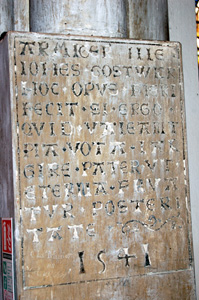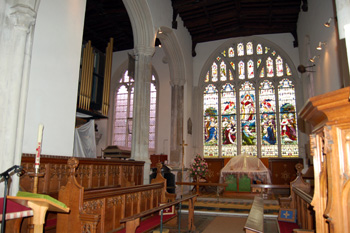Willington Church Architecture
![Willington church from the east in 1812 by Thomas Fisher [LL18/52]](/CommunityHistories/Willington/WillingtonImages/LL18-52_350x259.jpg)
Willington church from the east in 1812 by Thomas Fisher [LL18/52]
Sir Nikolaus Pevsner in the Bedfordshire volume of his Buildings of England series is unusually fulsome in his praise for a Bedfordshire church, referring to Saint Lawrence's as "A historically important church, as it is all Late Perpendicular". There was a church here long before that style of architecture developed, however.

Beast at the south side of the chancel east window August 2010
Willington is mentioned in the Domesday Book of 1086 and it is reasonable to assume that there was a church in the village before the Norman Conquest of 1066. The earliest known vicars date to the 13th century but it is known that the advowson of the church was granted to Newnham Priory in 1166.

Plaque above the tomb of Sir John Gostwick August 2010
It seems possible that Sir John Gostwick entirely rebuilt the church in the early 16th century. he certainly had the money to do so. A plaque next to his tomb notes that work was completed in 1541 and the most obvious conclusion is that it refers to work on the chapel but may, perhaps, also embrace any rebuilding which might have occurred. The issue is probably worthy of investigation by experts in the field of church architecture.

Looking across the chancel into the Gostwick Chapel August 2010
The church is built of a buff coloured stone and comprised, by 1541, a west tower, south porch, nave, north aisle, chancel and, north chapel. This latter is known as The Gostwick Chapel as it is where Sir John and other family members have their monuments. Two helmets and a tabard, which were all ascribed to Sir John, are positioned in the Chapel and a third helmet is located on the south wall of the chancel. Local historian Dorothy Jamieson, however, notes that the tabard was probably made later, in the late 16th or 17th century and painted to include the coats of arms of wives who married into the Gostwick family. The tilting helm in the church today and pictured below is a copy, the original being on loan to the Royal Armouries in Leeds. It lacks the spike on which Gostwick's emblem would have been placed.

Copy of the tilting helm of Sir John Gostwick August 2010